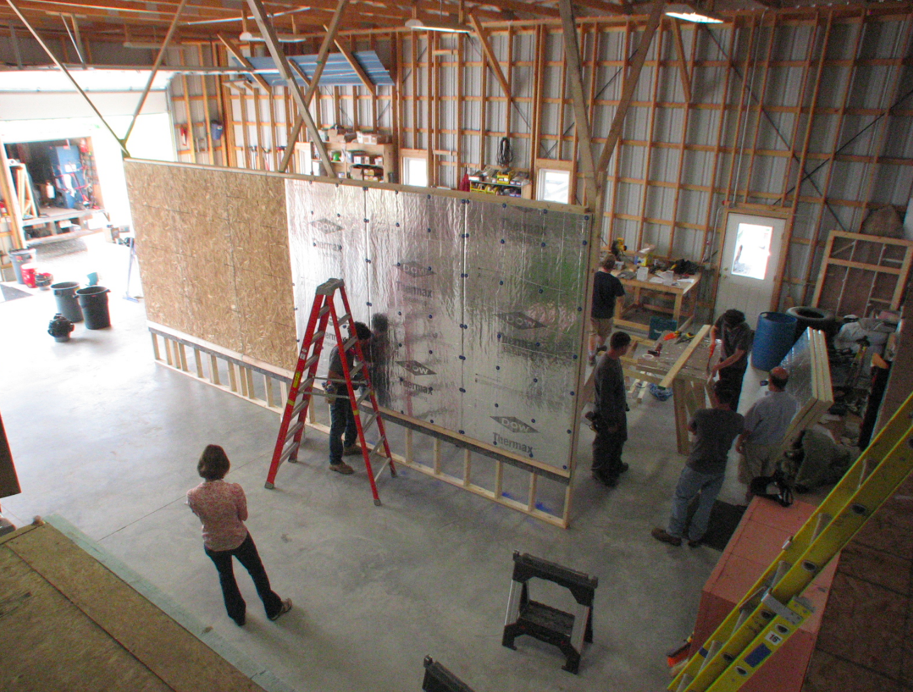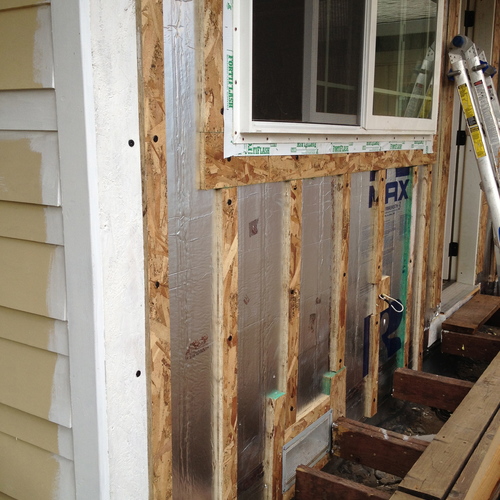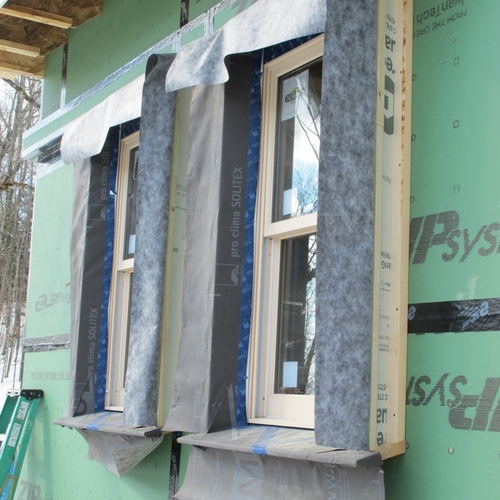
Image Credit: Joel Schuman
Christopher Peck’s original post, The Big Rewards of a Deep Energy Retrofit, was published here on March 15, 2016. That blog and this one both originally appeared at The Resilient Investor.
My article on deep energy retrofits generated several questions about how these types of retrofit add value to a house over time. How does a deep energy retrofit compare to something like a kitchen remodel? Is it worth the cost of doing the retrofit? If I spend $50,000 on a deep retrofit, will it add $50,000 to the value of my house?
Probably not. Or, it depends. Maybe. Possibly. It’s a tricky question, with some complex answers.
Let’s start with whether you plan to sell your house soon or not. If you are planning to sell in the next few years, or are forced to sell, the return-on-investment picture is probably pretty bleak. We can draw some clues from other big remodel projects. Looking at the numbers might scare you.
At mid-range national averages for 2015, adding a steel door is the only remodel project that adds value. That is, you’ll recoup a little more than you spent to buy and install it. (Move quickly before a toddler dings up that new door!) All of the other remodel projects are a losing proposition. It’s even worse for upscale projects, where the best ROI is upgrading to fiber-cement siding, and it doesn’t recoup even 85% of the $15,000 average cost of the project.
But anyone spending $100,000 on a deluxe kitchen upgrade isn’t doing it to make money when they sell – they’re doing it to improve their quality of life while living in the house. A temporary reduction in full value because of a quick sale isn’t anyone’s best financial plan. I think this will be true for deep retrofits as well.
Some new features pay off, but probably not energy upgrades
Some remodels do add value even when a house is sold soon after, particularly in hot real estate markets. Sometimes specific projects are in high demand from buyers or make a big difference in how buyers perceive a property.
As the folks at Remodeling put it, “If a remodeling project helps a house meet buyers’ expectations — adding a second bathroom in an area where every other home already has two — the homeowner can expect a good return either in the form of a higher selling price, a quick sale, or both (assuming everything else about the house is up to standard).” Unfortunately, this is unlikely to apply to deep retrofits, thanks to the current low cost of home heating fuel and the pitiful status of energy efficiency on most buyer’s checklists (10 of 10?).
There are other problems in realizing the full financial value of a deep retrofit. A 2012 paper by Cynthia Adams, “Valuing Energy Efficiency in the Real Estate Community,” highlights the complexity of the real estate market and the many stakeholders in residential home transactions who are ignorant of energy efficiency and its contribution to home value or the long-term costs of ownership. Add in the lack of a standardized home energy rating system, and it’s no surprise that change is happening slowly.
There’s one more factor in realizing full value in a deep retrofit, and it’s a big one: the number one factor in real estate value. You’ve heard this before: location. If you’re in a substandard location, such as right next to a busy interstate highway, it’s very difficult to envision a scenario where you could realize the full value of your investment.
Location problems can be specific to a house but can also be regional. We’ve probably all visited ghost towns in the West that were once bustling outposts but are now just a scattering of foundation stones. Or perhaps you’ve heard about mansions in Detroit selling for $1,000. It’s very difficult to realize value on your home improvement investments when the entire region is going through an economic depression. Conversely, there are some markets in which those grim payback numbers look much better than the national averages.
Look at the long-term returns
OK, enough of the negative perspective. If you are not planning to sell in the next five years or so, and assuming you live somewhere that’s not about to become a ghost town, then it matters less what the improvements have done for your home’s immediate resale value. I think a good argument could be made for the long-term realization of return, if we look beyond just the resale value of the home. After all, when looking at a long-term stock investment, we include both the eventual selling price and the annual dividends received along the way in our assessment of the returns.
Reducing ongoing and future maintenance costs is a big deal. The previously mentioned fiber-cement siding is a good example. If properly installed it should last 50 years and require paint perhaps only once a decade. That’s a substantial savings, one that follows directly from the initial investment.
I discussed using less energy in last quarter’s article, but remember that value will compound over the years as well: every hundred dollars saved each year is a hundred more you can save or invest toward other goals, either of which will pay their own returns over time. Reducing the energy demand of a house can also make it much easier to afford a complete photovoltaic system, or even to add more solar panels to fuel an electric car.
With careful attention and enough insulation you can “tunnel through the cost barrier” (an Amory Lovins phrase) and eliminate the need for a furnace or air conditioner at all; now you’re talking some substantial annual financial benefit! Or perhaps you’ll only need a $1,000 ductless minisplit heat pump to efficiently heat, cool, and dehumidify your house.
What is comfort worth? How do you value the improvement in quality of life that comes from living in a more comfortable, functional, and well-tuned home? What value do we place on reducing carbon emissions related to our own life choices? My answers to these last few questions float somewhere in the region of a lot, priceless, incalculable, and vast. How would you value these?
Weekly Newsletter
Get building science and energy efficiency advice, plus special offers, in your inbox.















4 Comments
No regrets remodeling
It seems like the thinking here is tending towards the concept, perhaps best encapsulated in the book title "No Regrets Remodeling," that you do renovations motivated by other things than energy, but as you go, include upgrades where the work opens opportunities for it. As noted in this article, upgrades can include upgrades in durability and comfort as well as energy efficiency.
Another factor to consider for those who care about their environmental impact is the concept of considering your "handprint" as well as your "footprint". Perhaps doing a project well, even at high cost, can help shift the industry toward higher-performance building. I have no illusions that my contractors will all do all their future projects to the same standards that I am asking for--it's an industry that is pretty slow to change. But for that very reason--that the industry is slow to change--the efforts of millions of GBA readers are needed if we expect the industry to shift.
Ugh- Why do that to that beautiful brick home ?
Hiding that beautiful brick work under layers of insulation and siding is cringeworthy.
There needs to be a better balance between efficiency and architectural preservation. It may not have been a historic building, but that home as it stood added character and beauty to the neighborhood that cannot be replicated today.
Vintage architecture should not be sacrificed during a deep energy retrofit.
Kurt
Response to Kurt Kiley
Kurt,
The photo that accompanies this article is intended to depict an example of a deep energy retrofit job. It does not depict the author's house.
The photo depicts work on Joel Schuman's house. Schuman is the man who coined the term "Dudley box."
For more information on Schuman's project, see Window Installation Tips for a Deep Energy Retrofit.
Schuman described his house as an "old, cold, drafty house in Saugerties, New York, ... poorly and cheaply built in the 1840s (apparently from scraps and salvage)."
House, home?
As my spouse and I walk though older sections of cities we visit, I look at older homes and say "nice, cool, beautiful, wow" but in the back of my mind I say 'schmuck, idiot, Duh!, moron and think of all the waste of energy pouring through those walls and widow frames. Yes, it would be nice to see great wood and brick work, but not at the expense of our national health. Now I see some wild looking Scandinavian designed Zero energy homes and say "Ugh" but "way to go!" Adapt and move forward. Most of all stop wasting energy, that's my air I have to breath and water I have to drink. PK
Log in or create an account to post a comment.
Sign up Log in